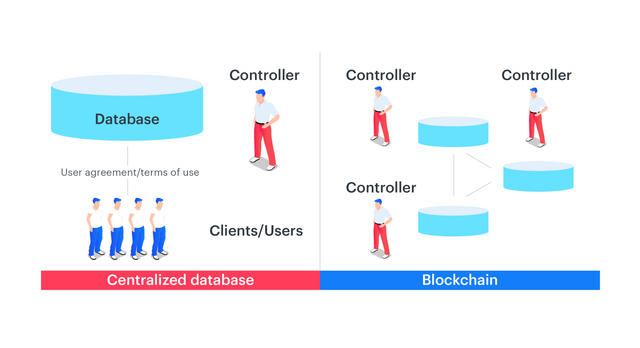The Blockchain as a Database

Image Source
In layman's terms, we can define a database as a library of related data that is being stored on a computer system. Some of the activities on the blockchain are just like the storage of data in a database, but in a more sophisticated manner. Hence, with regards to structure and functionalities, the blockchain is a more advanced database system.
With the relational database, data is stored in structures in a tabular form and they are fully centralized. The blockchain stores data in blocks in the form of a distributed ledger, making it decentralized. The advanced functionalities of the blockchain when it comes to the storage of data make it outstanding. It has contributed greatly to various industries, and if it is fully adapted as the main form of data storage, it will enable a trustless environment in handling data. The blockchain can offer the services of any database, but the traditional database system can not offer the functionalities of a blockchain.
In the early days, databases were used in flat file systems, where people could store simple information in a hierarchical order using flat files. As time elapses and new ideas keep evolving, the flat file database storage was advanced to relational databases where more complex data could now be stored in advanced data structures, which are in the form of tables where databases from different databases could easily be related. This is currently the type of database that is commonly used by almost everybody. This kind of database is managed by a database administrator, and he/she can easily alter its contents. This makes it fully centralized as the administrator has full control over the data. There are so many administrative privileges in the traditional database.
The blockchain, on the other hand, performs a lot of functionalities, including the storage of information. It is widely known as a means of validating transactions, but when you take a closer look at how it works, you will realize that it is a trusted source of data storage and we can utilize it as a means of storing our data. It is more secure and centralized than relational and hierarchical database systems.
Here, the data is stored in blocks which are validated by different nodes connected together from different parts of the work in a peer-to-peer fashion. The blockchain uses hashing to link the blocks together. When a new block is created, it will hold a hashed code of the previous block. This makes it cryptographically secure and extremely difficult to hack. Every new block of data has a relationship with the previous data, and this is how the data is distributed from the latest block to the genesis block.
With all these, you will realize that there is no central administrator who has the power to modify the information in a blockchain and that it is openly available in the ledger. This makes it centralized, and there is high confidentiality in storing data through the blockchain. The performance of the earlier blockchains was much slower, but there has been a recent evolution of blockchain technologies that emphasizes increasing the performance. This is just basic information as far as the blockchain technology is concerned. If you take your time to read about the development of the blockchain technology, you will realize that it is indeed a revolutionary technology.
Thanks for your time.
